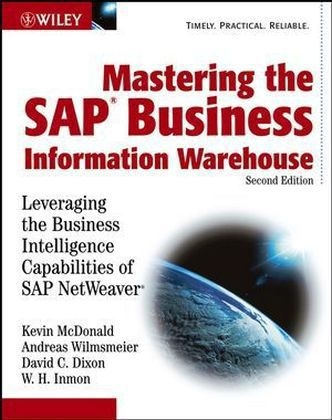
Mastering the SAP Business Information Warehouse
John Wiley & Sons Inc (Verlag)
978-0-7645-9637-7 (ISBN)
- Titel ist leider vergriffen;
keine Neuauflage - Artikel merken
The authors begin with an introduction to BI and SAP NetWeaver and quickly progress to information modeling and enterprise data warehouse concepts. You'll learn how to access and deliver meaningful analytic information to the organization, as well as perform integrated planning functions. Finally, the authors share invaluable insight on warehouse administration, performance, and security. With more than 50 percent new or revised material, this second edition of Mastering the SAP Business Information Warehouse shows you how to: * Extract data from online transaction processing systems * Store transformed data in a way that best supports reporting and analysis * Use the various Business Explorer tools such as BEx Report Designer, BEx Analyzer, BEx Broadcaster, and BEx Web Application Designer * Schedule, monitor, troubleshoot, and archive data loads The companion Web site contains sample chapters in Wiki format and the authors' blog where readers may enter discussions about the book and SAP. Wiley Technology Publishing Timely. Practical. Reliable. Visit our Web site at www.wiley.com/compbooks/ Visit the companion Web site at www.wiley.com/compbooks/mcdonald The companion Web site contains the sample code presented in the text of the book, plus implementation templates.
Kevin McDonald is a consultant and entrepreneur. He cofounded and was the CEO of COMPENDIT, Inc., a consulting services firm acquired by Inforte Corp. in 2004. He was an Ernst and Young Entrepreneur of the Year regional finalist and was recognized by Entrepreneur magazine for having created a "Hot 100" fastest-growing new business. He has instructed, implemented, and designed enterprise decisionprocessing systems for dozens of clients. Prior to co-founding COMPENDIT, Kevin was the Director of New Dimension Technology and a corporate spokesperson for SAP, where he had worked in both America and Germany. He was program manager during the successful market launch of SAP Business Information Warehouse (SAP BW), and he authored the SAP BW product map that was first used to define the scope and development direction for the software. Kevin started his career at Baxter Healthcare, where he held positions in both IT and finance functions. He has authored numerous articles about SAP's Business Intelligence Solution for The Data Warehouse Institute's newsletter, and he has made presentations on business intelligence at DCI's Data Warehouse World, HP World, ERP World, TDWI conferences, ASUG, SAP TechEd, SAP Sapphire, Decision Processing 98 and 99, and Informatica World. Kevin is an advisor to the Cognos Innovation Center and may be contacted at kevin.mcdonald@renditionx.com. Andreas Wilmsmeier is a managing director of Inforte Deutschland. Andreas has been a member of the initial SAP BW core development team, where he has been responsible for designing and implementing parts of the Staging Engine (for example, the Staging BAPI). Andreas has been consulting SAP BW clients since the initial customer shipment of SAP BW 1.2A in early 1998 and has continued to contribute to the development of SAP BW by providing feedback from the field and to the development of business content for the financial services and defense industries. After receiving his diploma in computer science and business economics, Andreas started his career in developing data warehouse and Internet solutions. Prior to working for Inforte, Andreas ran the German subsidiary of COMPENDIT until its acquisition by Inforte in early 2004. His knowledge of data warehousing, data mining, and knowledge management has been showcased at numerous international conferences, including SAP Sapphire, SAP TechEd, ASUG, Cebit in Hanover, Germany, and Systems in Munich, Germany. Andreas has authored articles in the SAP Technical Journal, (now featured on intelligentERP.com) and the German-language E/3 Magazine. Andreas may be contacted at andreas.wilmsmeier@inforte.com. David Dixon is a vice president with Inforte's SAP Practice, where he is responsible for ensuring the quality of Inforte solutions and project deliveries. A recognized authority in business intelligence, he has extensive full-lifecycle project experience in architecting and implementing complicated global solutions for Fortune 100 companies. David has also worked with the SAP SEM and SAP BI development teams on numerous occasions in support of the latest products. Prior to joining Inforte, David worked for COMPENDIT, a consulting firm acquired by Inforte in March 2004, where he was a founding team member. Prior to joining COMPENDIT, he was a Platinum Consultant with SAP. David started his career as a Financials and Controlling (FI/CO) consultant with SAP in 1995, specializing in all of the SAP reporting and analysis applications and tools. An accomplished speaker, he has presented at industry-leading SAP and BI events, including SAP TechEd, ASUG, and TDWI. He may be contacted at david.dixon@inforte.com. Bill Inmon is thought of as the "father of the data warehouse" and is co-creator of the "corporate information factory." He has more than 28 years of experience in database technology management and data warehouse design. He is known globally for his seminars on developing data warehouses and has been a keynote speaker for every major computing association and many industry conferences, seminars, and trade shows. Bill has written about a variety of topics on building, usage, and maintenance of the data warehouse and the corporate information factory. More than 500 of his articles have been published in major computer journals such as Datamation, ComputerWorld, and Byte magazine. Bill is currently a columnist with Data Management Review and has been since its inception. He has published 39 books. Bill founded and took public a Silicon Valley company, Prism Solutions, in 1991. Prism Solutions became Ardent Software, which was acquired by Informix, renamed Ascential Software, and acquired by IBM. The software he created is still used by hundreds of companies today. More recently, Bill decided to publish his vast data warehousing information resources on his Web site at www.billinmon.com. The Web site has now grown to support millions of visitors a month. Bill consults with a large number of Fortune 1000 clients, offering data warehouse design and database management services.
About the Authors. Foreword. Acknowledgments. Introduction. Chapter 1 The Origins of Business Intelligence. Evolution of Information Processing. Data-Storage Advancements. Transaction Processing Dominates. Extract Files Appear. The Data Warehouse Is Conceived. What Is Data Warehousing? The Data Model. Different Physical Tables. Integration and Transformation Processing. Metadata. Granular Data. Historical Data. Timestamping. Data Relationships. Generic Data versus Specific Data. Data Quality. Volumes of Data. Removing Dormant Data. Architected Solutions. Corporate Information Factory. Government Information Factory. Evolution of SAP. Evolution of SAP Reporting and Analysis. SAP BW and the New Dimension Applications. The Road to Business Process Integration. Summary. Chapter 2 The SAP NetWeaver Integration Platform. The Architectural Roots of SAP NetWeaver. NetWeaver Overview. Application Platform (Technology). Application Server Architecture. Front-End Technologies. Mobile Infrastructure. System Landscape. Security. Administration. Process Integration. Integration Builder. Integration Repository. Integration Directory. Integration Server. Runtime Monitor. Information Integration. Business Intelligence. Master Data Management. Knowledge Management. People Integration. Portal Framework. Composite Application Framework. Summary. Chapter 3 SAP Business Information Warehouse Architecture. SAP BW Architectural Components. Metadata and Document Management. Metadata Management. Document Management. Elementary Metadata Objects. Obsolete Metadata Objects. Design, Monitoring, and Administration. Design. Monitoring. Administration. Data Acquisition and Transformation. Most Important Metadata Objects. Staging Engine. DataSource Manager. Data Storage. Master Data Manager. Data Store Object Manager. InfoCube Manager. Aggregate Manager. BI Accelerator. Information Lifecycle Manager. Data Access and Analysis. InfoProvider Interface. ODS BAPI. OLAP Cache. Analytic Engine. Analysis Process Designer. Information Distribution. Information Distribution Interfaces. Broadcasting. Presentation. Presentation Metadata Objects. BEx Analyzer and BEx Web Analyzer. BEx Query Designer. BEx Report Designer. BEx Web Application Designer. BI Patterns. Visual Composer. Planning. Analytic Engine. Planning Functions. Planning Sequences. Summary. Chapter 4 Information Modeling. Information Modeling Prerequisites. Understanding the SAP BW Metadata Model. Master-Data Data Model. The InfoCube Data Model. The DataStore Object Data Model. Developing an Information Model. Multidimensional Modeling. Additional Information Modeling Options. Summary. Chapter 5 Enterprise Data Warehousing. Business Intelligence Strategy. Architecture. Layers of an EDW Architecture. Topology. System Landscapes. Data Integration. Master Data Integration. Transaction Data Integration. Data Quality. Modeling the Layers of an EDW. Modeling the Data Staging Layer. Modeling the Operational Data Store. Modeling the Data Warehouse Layer. InfoMart Layer. Modeling Support for Data Integration. Modeling with Global Keys. Modeling with Qualified Local Keys. Concatenation Versus Compounding. Mapping Approaches. Modeling Support for Data Historization. Tracking History of Transactional Data. Tracking History of Master Data. Governance. Standards. Organization. Processes. Training. Project Marketing. Summary. Chapter 6 Data Acquisition and Transformation. Data Acquisition. Classes of Data. Data Flow and Integration. Dimensions of Data Acquisition. OLTP Technology Considerations. Architecture. Metadata Flow. Data and Control Flow. Example of an Application-Specific Extractor. Client-Specific Data Extraction Options. Architecture. Data and Control Flow. Architecture. Data and Control Flow. Data and Control Flow. Architecture. Data and Control Flow. Ascential DataStage. Architecture. Data and Control Flow. Transformation. Data Integration Transformations. Application Logic Transformations. Reference Objects for Transformations. Architecture and Data Flow. Persistency Considerations. Multilevel Staging Considerations. Conversion Routines. Aggregation. Rule Types. Transformation Routines. Loading. Master Data Texts. Master Data Hierarchies. Summary. Chapter 7 Data Access, Analysis, and Information Distribution. Data Access. Query Processing Overview. InfoProvider Interface. DataStore Objects and PSA APIs. Information Analysis. Knowledge-Discovery Process. Analytic Services. Information Distribution. Broadcasting. Interface Options for Third-Party Presentation Tools. The Business Explorer API. Summary. Chapter 8 Information Presentation. BEx Presentation Components. BEx Query Designer. BEx Analyzer. BEx Web. Generic Presentation Options. Personalization. Print Versions - PDF Output. Local Calculations. Other Presentation Options. Crystal Reports Integration. BEx Mobile Intelligence. Portal Integration. Visual Composer. Summary. Chapter 9 Integrated Planning. Integrated Planning Positioning. History and Trends. Definition of Planning. Architecture Considerations. Integrated Planning Technology. Architecture. Evolution. Planning Modeler. Integrated Planning Data. Information Logistics. Information Modeling. Data Access and Locking. Semantic Rules. Planning Functions. Controlling Function Behavior. Function Types. Basic Functions. Advanced Functions. Integrated Planning User Interface. Runtime Capabilities. Design-Time Capabilities. Integrated Planning Process Control. Status and Tracking. BW-BPS Coexistence. Best and Worst Practices. Delta Change Modeling. Enterprise Design. Summary. Chapter 10 Business Analytics. Analytic Application Architecture. What Is Business Content? Business Content Progression. Horizontal Growth. Vertical Growth. Using Business Content. Myths. Usability. Challenges. Customer Relationship Analytics. Analytic Engines. Customer Behavior Analysis. Supply Chain Analytics. SCOR Model. Supply-Chain Cockpit. Demand Planning (DP). Network Design and Production Planning. Financial Analytics. Corporate Performance Management. Enterprise Planning. Financial Consolidation. Summary. Notes. Chapter 11 Administration. Application-Oriented Administration. Process Chains. Data Management Processes. Application Management Processes. Monitoring. Troubleshooting. System-Oriented Administration. Information Lifecycle Management. Authorizations. Transports. Upgrades. Summary. Chapter 12 Performance Planning and Management. Performance Planning. Managing User Expectations. Information Modeling. Process Design. System Landscape Design and Setup. Performance Management. BI Statistics. Optimizing Query Performance. Data Loading and Data Management. Information Lifecycle Management. System Performance. Summary. Appendix A Acronyms. Index.
| Erscheint lt. Verlag | 15.9.2006 |
|---|---|
| Zusatzinfo | Illustrations |
| Verlagsort | New York |
| Sprache | englisch |
| Maße | 195 x 242 mm |
| Gewicht | 1224 g |
| Einbandart | Paperback |
| Themenwelt | Mathematik / Informatik ► Informatik ► Datenbanken |
| Informatik ► Office Programme ► Outlook | |
| Mathematik / Informatik ► Mathematik ► Finanz- / Wirtschaftsmathematik | |
| ISBN-10 | 0-7645-9637-3 / 0764596373 |
| ISBN-13 | 978-0-7645-9637-7 / 9780764596377 |
| Zustand | Neuware |
| Haben Sie eine Frage zum Produkt? |
aus dem Bereich


